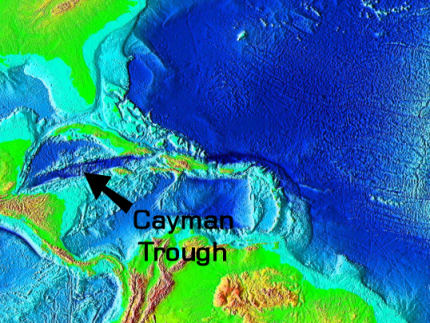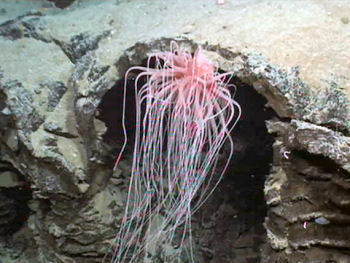Biology
The Cayman Trough contains a short chain of undersea volcanoes that is separate from the rest of the world's mid-ocean ridge system. Finding out what lives at vents in the Cayman Trough, and how it differs from that found at vents elsewhere on the mid-ocean ridge, should reveal what shapes the web of life throughout the deep ocean.
The species that scientists have found at deep-sea vents in the eastern Pacific (e.g. tubeworms and clams) are different to those seen so far at vents in the Atlantic (e.g. shrimp and anemones). But before the continents of North and South America joined around 3 to 5 million years ago, there was a seaway between the two oceans through the Caribbean. So the marine life at deep-sea vents in the Cayman Trough may provide evidence of the 'missing link' between the two oceans.

Today, deep ocean currents link the Atlantic to the Cayman Trough. So if the species we find there are related to those in the Atlantic, that would tell us that modern ocean currents are the key to determining patterns of marine life. But if the species we find are related to those at vents in the eastern Pacific, that would indicate that geological history is more important.
Alternatively, we may find species unlike any seen before. The Cayman Trough may be like Conan Doyle's 'Lost World' - where that was an isolated plateau, this is an isolated deep basin. The deep sea is still full of surprises - 'I was wrong' and 'I don't know' are common phrases for deep-sea biologists. But if we find surprises in the depths of the Trough, they will reveal the effects of isolation on the distribution and evolution of species in the deep ocean.

So whichever way our discoveries turn out, they should advance our understanding of the ecology of our planet's largest and least-known habitat - the deep ocean. And perhaps equally importantly, we hope they will also help to keep alive our sense of wonder at the world around us. As John Steinbeck once wrote, an ocean without unnamed monsters would be like sleep without dreams.
Page 1: Life at deep-sea vents
Page 2: Why should anyone care about patterns of life in the oceans?
Page 3: Why are we investigating the Cayman Trough in particular?
Want to dive deeper?
Read more about life at vents in Citizens of the deep
Visit Venture Ocean to find out more about vent biology
Explore the biogeography of vents in an article by Cindy Van Dover
Read more on vent ecology in a feature from the British Ecological Society Bulletin
Visit Deep Sea News for a blog post about the life-cycles of vent animals
Download a news feature about recent vent discoveries from the journal Nature
(personal or institutional subscription required)
Download a review paper about vent biogeography from the journal Science
(personal or institutional subscription required)
Science
Find out more about the Cayman Trough, undersea volcanoes, deep-sea vents,
and the inhabitants of the abyss.
What are we investigating?


